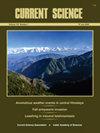Irrigation water policies for sustainable groundwater management in irrigated northwestern plains of India
IF 1
4区 综合性期刊
Q3 MULTIDISCIPLINARY SCIENCES
引用次数: 0
Abstract
Increasing global water shortage emphasizes the need for demand-side water management policies, especially in the agriculture sector, being the largest consumer of freshwater. Such policies are relevant in India, where groundwater depletion may have severe implications at various socio-economic levels. In this study, using mathematical modelling, we assess the feasibility of two alternative irrigation water pricing policies – (i) uniform water pricing policy and (ii) differentiated water pricing policy, wherein farmers growing less water-requiring crops (<4488 m 3 /ha) get an incentive for saving water, while those growing water-intensive crops pay for it. Using a case study of Punjab, the breadbasket and one of the fastest groundwater-depleting states in India, alternative cropping patterns are also suggested. The findings reveal that the current rate of groundwater withdrawal could not sustain agricultural intensification in the state. Although optimization of resource allocation has the potential to save water by 8%, this alone is unlikely to break the rice–wheat mono-cropping pattern in Punjab. The analysis of two different volumetric irrigation water pricing policies shows that differentiated water pricing would be more effective in halting groundwater depletion in the state. However, adequate investment in irrigation water supply infrastructure, mainly for installing water meters, is required to implement the policy.印度西北灌溉平原地下水可持续管理的灌溉用水政策
日益严重的全球水资源短缺强调需要需求方的水管理政策,特别是在作为淡水最大消费者的农业部门。这种政策适用于印度,因为印度的地下水枯竭可能对社会经济各阶层产生严重影响。在本研究中,我们使用数学模型,评估了两种替代灌溉水价政策的可行性——(i)统一水价政策和(ii)差异化水价政策,其中种植较少用水作物(<4488立方米/公顷)的农民获得节水激励,而种植水密集型作物的农民则为此付出代价。通过对印度的粮仓和地下水消耗最快的邦之一旁遮普邦的案例研究,还提出了替代的种植模式。研究结果表明,目前的地下水抽取速度无法维持该邦的农业集约化。尽管优化资源配置有可能节约8%的水资源,但单凭这一点不太可能打破旁遮普稻麦单作模式。对两种不同的容积灌溉水价政策的分析表明,差别水价在遏制该州地下水枯竭方面更为有效。然而,要实施这一政策,需要对灌溉供水基础设施进行足够的投资,主要是安装水表。
本文章由计算机程序翻译,如有差异,请以英文原文为准。
求助全文
约1分钟内获得全文
求助全文
来源期刊

Current Science
综合性期刊-综合性期刊
CiteScore
1.50
自引率
10.00%
发文量
97
审稿时长
3 months
期刊介绍:
Current Science, published every fortnight by the Association, in collaboration with the Indian Academy of Sciences, is the leading interdisciplinary science journal from India. It was started in 1932 by the then stalwarts of Indian science such as CV Raman, Birbal Sahni, Meghnad Saha, Martin Foster and S.S. Bhatnagar. In 2011, the journal completed one hundred volumes. The journal is intended as a medium for communication and discussion of important issues that concern science and scientific activities. Besides full length research articles and shorter research communications, the journal publishes review articles, scientific correspondence and commentaries, news and views, comments on recently published research papers, opinions on scientific activity, articles on universities, Indian laboratories and institutions, interviews with scientists, personal information, book reviews, etc. It is also a forum to discuss issues and problems faced by science and scientists and an effective medium of interaction among scientists in the country and abroad. Current Science is read by a large community of scientists and the circulation has been continuously going up.
Current Science publishes special sections on diverse and topical themes of interest and this has served as a platform for the scientific fraternity to get their work acknowledged and highlighted. Some of the special sections that have been well received in the recent past include remote sensing, waves and symmetry, seismology in India, nanomaterials, AIDS, Alzheimer''s disease, molecular biology of ageing, cancer, cardiovascular diseases, Indian monsoon, water, transport, and mountain weather forecasting in India, to name a few. Contributions to these special issues ‘which receive widespread attention’ are from leading scientists in India and abroad.
 求助内容:
求助内容: 应助结果提醒方式:
应助结果提醒方式:


